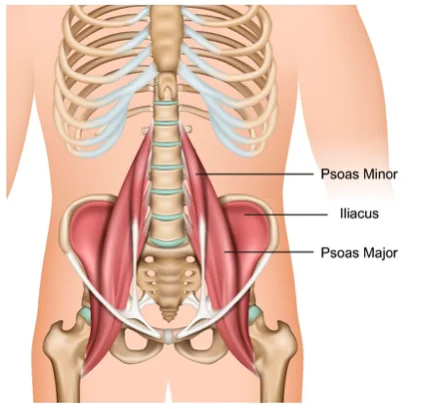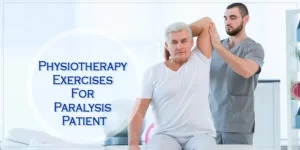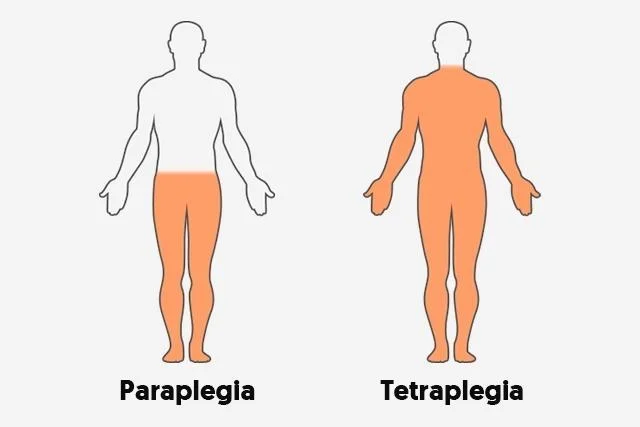Vertigo
What is Vertigo?
Vertigo is a sense of being off balance. When you get dizzy spells, you may feel as if you are spinning or the world around you is moving. Vertigo often originates from an inner ear issue. This sensation might be mild or severe, making it difficult to maintain your balance and do daily duties.
Vertigo attacks can occur quickly and last only a few seconds, or they might continue considerably longer. If you have severe vertigo, your symptoms may be persistent and linger for many days, making it difficult to go about your daily activities.
Other signs and symptoms of vertigo might be:
- Dizziness or feeling unwell
- Imbalance, which might make it challenging to walk or stand
What is a sense of dizziness?
Exercise can help relieve vertigo, which is the sensation that you are spinning while still or that your environment is moving. This illness is brought on by tiny calcium carbonate crystals that come from another area of your enter your inner ear’s semicircular canal. These workouts aid in the crystals’ redistribution.
A dizziness that comes on suddenly and without any accompanying movement is called vertigo. It results from your senses informing your brain. that, although being balanced, your body is unsteady. Vertigo is not a diagnosis in and of itself; rather, it is a sign of an underlying illness. It has multiple potential sources for it.
Many people frequently experience vertigo; it is not an uncommon condition. However, the situation can change. This disease makes people feel lightheaded and unsteady. As vertigo is not an illness but rather a sign of many illnesses, it can be managed with targeted workouts in addition to medical care.
Prior to going over these exercises again, it’s crucial to understand that vertigo comes in two varieties:
- An issue with the vestibular nerve or inner ear is the cause of peripheral vertigo. Roughly 93% of occurrences of vertigo are caused by it.
- A brain issue is the cause of central vertigo.
What are Vertigo’s Causes?
Vertigo can be caused by several factors. This illness causes dizziness and a constant sensation of spinning in the brain in its victims.
There are two different kinds of vertigo: peripheral vertigo and central vertigo. The former happens when there is a brain problem. The latter, on the other hand, is connected to an inner ear issue.
The most frequent cause of vertigo is a chronic issue with the former. Such circumstances might arise from any disruption in the function of the ears, which regulate our body’s equilibrium.
These are the specific circumstances that can cause dizziness.
Positional vertigo that is benign paroxysmal (BPPV):
- This is the most prevalent ailment seen in individuals suffering from this illness.
- It usually activates when the position of the head changes.
- If you have this disease, for instance, you will feel dizzy when you lie down, rise up, or simply turn to face a different side of the bed.
The disease Meniere:
- Individuals who have this illness get vertigo episodes due to fluid accumulation in the ears.
- This illness is frequently linked to other illnesses such as tinnitus.
- It occurs when patients experience a ringing sound, fluctuate in their hearing loss, or feel as though their ears are full.
Cholesteatoma:
- When persons with recurrent ear infections develop noncancerous skin growths in their middle ears, it’s known as cholesteatoma syndrome.
- Vertigo, hearing loss, and dizziness can also result from it.
Vestibular Neuritis:
Any irritation of the vestibular nerves is meant by this. Vestibular neuritis does not cause hearing loss, in contrast to labyrinthitis. But this problem can also cause vertigo, nausea, and impaired vision.
There are additional medical diseases besides these that can also produce vertigo, such as:
- Migraine-like pain
- Prolonged rest in bed
- Head trauma
- Surgery on the ears
- Certain drugs
- Infarctions
- Brain illness
- Diabetes Epilepsy
- Orthostatic hypotension, also known as hypotension or low blood pressure, is a condition in which standing causes your blood pressure to drop.
- Shingles inside or close to the ear
- Sound neuroma
- Middle ear leakage of inner ear fluid is known as a perilymphatic fistula.
- Excessive breathing
- Ataxia, or weakened muscles
- Otosclerosis is a condition influencing the formation of bones in the middle ear.
- Multiple sclerosis
If you have a few symptoms, you can determine if you have this ailment. The majority of these symptoms are immediately identifiable and may persist for several minutes or even hours. It may also return more frequently at shorter intervals. But you need to see a doctor if you see any combination of these symptoms.
Symptoms:
The primary symptom is the feeling that you or the space are in motion or are spinning. Vomiting and nausea may result from the whirling feeling. Other symptoms that may arise depending on the etiology include:
- Difficulty focusing the gaze
- Wooziness
- hearing loss in one or both ears
- Imbalance loss, which could lead to falls
- An ear-ringing sensation
- Vomiting and nauseous, resulting in fluid loss
If your vertigo is caused by brain issues (central vertigo), you can also have the following symptoms:
- Having trouble swallowing
- Dual perception
- Issues with eye movement
- Facial immobility
- Slurred words
- Debility in the limbs
Diagnostic tests for vertigo:
Fukuda-Unterberger experiment:
- Your healthcare practitioner will instruct you to march in place for 30 seconds while closing your eyes.
- If you spin or lean to one side, this could indicate a problem with your inner ear labyrinth. This could result in vertigo.
Romberg’s examination:
- The doctor will ask you to close your eyes and stand with your feet together and your arms at your sides during this assessment.
- If you feel imbalanced or unsteady, you may have a problem with your central nervous system (brain or spinal cord).
Head impulse examination:
- The doctor will gently move your head to each side as you focus your eyes on a stationary object (such as a place on the wall or your provider’s nose) for this test.
- They will pay particular attention to your eye movements while they move your head.
- This can tell them whether there is a problem with your inner ear’s balancing system.
Vestibular testing equipment:
- This comprises a variety of tests to evaluate the vestibular region of your inner ear system.
- A vestibular test battery can assist in determining if your symptoms are caused by an inner ear problem or a brain problem.
Treatment:
Whenever feasible, the cause of any brain condition causing vertigo should be found and addressed. Medication may be administered to you to address peripheral vertigo symptoms including nausea and vomiting. Balance issues may be improved with physical treatment. You’ll learn balancing exercises to help you regain your equilibrium. In order to help prevent falls, exercises can also help strengthen your muscles.
Try the following to stop your symptoms from getting worse during a vertigo episode:
- Be motionless.
- When symptoms appear, lie down or sit down.
- Restart activities gradually.
- Don’t move positions quickly.
- When symptoms appear, avoid attempting to read.
- Keep bright lights away.
Walking assistance may be necessary when symptoms appear. Steer clear of risky tasks including driving, using large machinery, and climbing until one week has passed after the symptoms have subsided.
Other therapies vary depending on what is causing the dizziness.
How Can Physical Activity Help With Vertigo Relief?
- Since some forms of vertigo are linked to brain disorders, physical activity is not a reliable treatment for them.
- However, for those with peripheral vertigo, doctors advise the previously indicated exercise as a substitute course of treatment.
- As a result, the majority of them are made specifically to move calcium carbonate crystals out of the inner ear.
- How it builds of these crystals are the primary cause of hearing impairment.
- In addition to relaxing the neurological system, the majority of these activities are beneficial in reducing tension and anxiety.
- Thus, lending People lessen their symptoms of vertigo.
What are the possible side effects of vertigo?
Falls caused by vertigo can result in bone fractures (broken bones) or other injuries. Vertigo can also impair your quality of life and make it difficult to drive or go to work.
The ideal dizzy workout is:
Start carefully with these exercises for vertigo, and be aware that your early reactions can make the condition worse. Make sure to finish each of these exercises on your own, pausing in between. Before starting any of these activities, consult your doctor. Also, let them know if your vertigo symptoms worsen or if you experience any new ones.
These are a few exercises that can help reduce vertigo symptoms. They usually entail holding certain postures to increase balance or marching in place. The greatest exercises that will be most beneficial to you are listed below,
The Brandt-Daroff drills
- Place your feet on the floor and take a seat in the center of the bed.
- Make a 45-degree turn with your head.
- Lay down on your left side, keeping your head still.
- After the vertigo subsides, give it another 30 seconds.
- Hold this posture for thirty seconds if you are not experiencing vertigo.
- Afterward to your neutral position.
- Then unwind.
- Get back to where you were before.
- Take a 30-second break.
- Rotate your head to face 45 degrees left.
- On the right side, repeat steps two and three. Hold this posture for 30 seconds.
- Afterward to your neutral position.
- Then unwind.
- Do this five to ten times over.
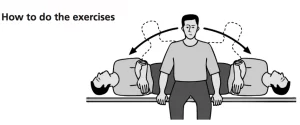
Epley maneuver
- Hang on a bed’s edge.
- Rotate the head 45 degrees to the right, or as far as is comfortable.
- Quickly recline.
- Hold this posture for half a minute.
- To make the head 45 degrees to the left, turn it.
- Hold this posture for half a minute.
- Take a further 90 degrees to the left with the head and body to enter the bed.
- Hold this posture for half a minute.
- Sit up slowly.
- Afterward to your neutral position.
- Then unwind.
- Do this five to ten times over.
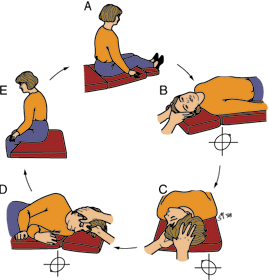
Foster Maneuver
- Knead with your hands on the ground.
- Lean your head back and forth.
- Hold off until any vertigo subsides.
- Tuck your chin in towards your legs and place your forehead on the floor.
- Face your left elbow by swiveling your head 45 degrees.
- Take a 30-second break.
- Raise your head until it is level with your shoulders and back while maintaining a 45-degree inclination.
- Take a 30-second break.
- Raise your head until it is completely upright.
- Afterward to your neutral position.
- Then unwind.
- Do this five to ten times over.
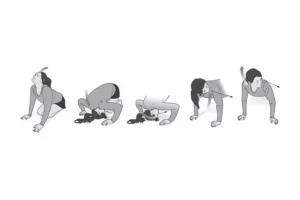
Seated Forward Bend
- Raise your arms overhead and straight out to the sides to extend your reach towards the ceiling.
- Take a breath and extend your back.
- Exhaling, start to lean forward, bending at the hips. Imagine your pelvis as a bowl of water that is tilted forward.
- During every breath, extend your backbone. To accomplish this, you might slightly tilt forward.
- As every breath out, go farther into your forward bend.
- Instead of your nose reaching your knees, picture your tummy resting on your thighs.
- This will assist you in maintaining a long spine.
- Maintain your neck’s natural extension from your spine by not fully letting it hang down or straining it upward.
- Choose whether to continue in this position or move forward when you have reached your maximum extension with your spine extended.
- Grasp your shins or ankles, whatever is most accessible.
- Another option is to bind a strap around your feet.
- Maintain flexed feet powerfully the entire time.
- Afterward to your neutral position.
- Then unwind.
- Do this five to ten times over.

Closing the Seven Gates
- Locate a peaceful area where you won’t be disturbed for a while.
- Lay down a yoga mat and take a cross-legged seat on it.
- You can sit in Padmasana or Veerasana if you are also meditating throughout this period.
- Maintain a straight back and regular breathing pattern.
- Before blocking your perception of your surroundings, try to feel them once.
- Raise your arms, maintain the elbow at shoulder level, and bring the palm to your face.
- With the assistance of your fingers, shut your mouth, nose, ears, and eyes.
- Put your thumbs against the tragus to block your ears.
- Using your forefingers, close your eyes, but remember to roll them upward while you do so.
- Use your middle finger to help partially block your nose.
- Your little and ring fingers should be gently placed on your upper and lower lips.
- Now take a deep breath and attempt to concentrate on it while you disconnect yourself from the outside world.
- With each breath, go a little bit more inward.
- You will eventually begin to hear the delicate sound of your own breath.
- Practice the Shanmukhi Mudra for a few minutes, then go back to where you were before.
- Exhale, clear your mind and bring your hands down to sit in either the Padmasana or the Veerasana.
- Afterward to your neutral position.
- Then unwind.
- Do this five to ten times over.
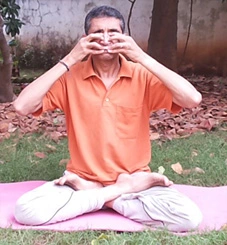
Diaphragmatic Breathing
- In a comfortable position, sit or lie flat on the floor.
- Placing a hand on your lower abdomen and another on your chest.
- Inhale slowly through your nose.
- Fill your tummy with air, taking in as much as you can.
- As you inhale, the hand on your tummy should raise.
- Exhale slowly through your mouth.
- Afterward to your neutral position.
- Then unwind.
- Do this five to ten times over.
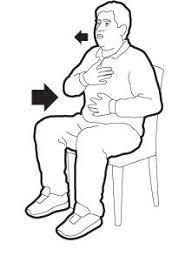
Gaze Stabilization Exercise
- Place yourself on a mat or sit on a chair or table.
- Extend one arm and extend your index finger.
- For 15 seconds, focus on your index finger.
- Slowly turn your head to the right and left, keeping your gaze fixated on the tip of your index finger.
- Repeat for 10 seconds.
- Move your head up and down while keeping your sight on the index finger.
- Repeat for 10 seconds.
- With your attention fixated on the index finger, move your head diagonally up and down. Repeat for 10 seconds.
- Afterward to your neutral position.
- Then unwind.
- Repeat on the other side.
- Do this five to ten times over.
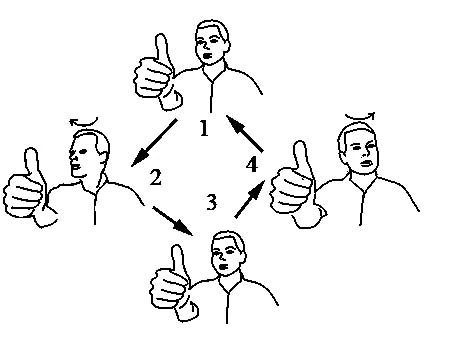
Romberg Stance
- Keep your feet close to your sides.
- You may cling on a chair or a wall.
- Cover the eyes.
- Maintain a straight head.
- For fifteen seconds, hold this.
- As you open your eyes, tilt your head to the side.
- Give it ten to fifteen seconds.
- Head movements up and down.
- For fifteen seconds, do this.
- Keeping your eyes closed, repeat the steps.
- Afterward to your neutral position.
- Then unwind.
- Do this five to ten times over.
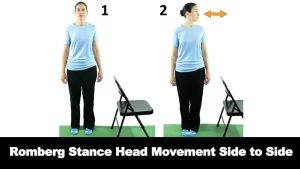
Standing Sway Exercise
- Similar to the Romberg exercise, stand with a wall behind you and a chair in front of you.
- Use the chair or wall if you begin to fall to assist.
- Place your feet shoulder-width apart.
- Lie your arms down by your sides.
- Learn a little bit to the front, then back (or right, then left).
- Don’t elevate your toes or heels; your weight should move accordingly.
- Your lower body and shoulders ought to move in unison; however, avoid bending at the hips.
- Afterward to your neutral position.
- Then unwind.
- Do this five to ten times over.
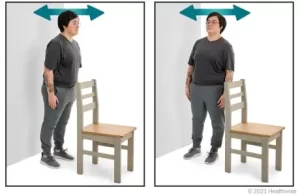
Marching in Place
- Similar to the Romberg exercise, stand with a wall behind you and a chair in front of you.
- Use the chair or wall if you begin to fall to assist.
- As you normally would, place your feet comfortably apart.
- Lie your arms down by your sides.
- Step into a march while raising your knees to the ceiling.
- With each session, gradually increase from 20 to 30 steps.
- Afterward to your neutral position.
- Then unwind.
- Do this five to ten times over.
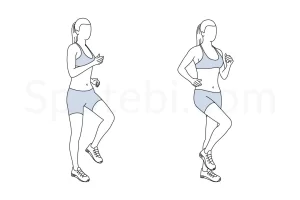
Corpse Pose (Savasana) in Yoga
- Put yourself on your back.
- Keep your legs apart.
- Give up trying to keep your legs straight and allow your feet to drop freely to either side.
- Raise your arms to your sides, a little apart from your body.
- Don’t attempt to keep your palms open when you turn them to face upward.
- Curl your fingers in.
- For support, tuck your shoulder blades into your back.
- This is a less intensive version of tucking the shoulders under in Bridge Pose.
- Let go of the need to hold your limbs in place once you have them positioned.
- Give your face and entire body a little relaxation. Allow your limbs to feel heavy.
- Let your breathing occur naturally.
- You can focus on your breathing if your thoughts stray, but try not to focus on it too deeply.
- Spend at least five minutes there. Better is ten minutes.
- Set an alarm if you are practicing at home so you won’t be distracted by constantly checking the time.
- To extend your entire body from your hands to your feet, raise your arms overhead.
- Closing your eyes, raise your legs to your chest and roll to one side.
- Assume a fetal position and use your lower arm as a pillow.
- Reposition yourself so that you are sitting again, using your hands to support yourself.
- Then return to your neutral posture.
- Then relax.
- Repeat these steps five to 10 times.
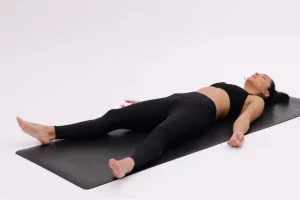
Walking on a flat surface
- Walk 10-15 steps on a flat surface with your eyes open, then turn around and walk back 10-15 steps with your eyes closed.
- Repeat the preceding while randomly tilting your head up/down and left/right.
- Return to your neutral position.
- Then unwind.
- Repeat these instructions 5–10 times.
- It is recommended that you have someone else supervise you while completing this exercise, preferably walking with you in case you fall.
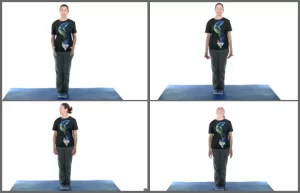
Which Exercises Should I Avoid If I Have Vertigo?
- Activities like swimming that require significant head motions might exacerbate vertigo.
- A stressful head causes calcium crystals to form in your ears much more quickly, which might impair your balance.
- Speak with an expert to learn more about the types of activities that can be incorporated into your workouts for strength training.
- Additionally, exercise your neck gently and cautiously.
- Given that vertigo may result from abrupt head movements, it’s important to use caution when selecting beneficial workouts.
- Certain workouts should be avoided when experiencing vertigo, such as:
- A step up
- Sit-ups
- Lunges
What Safety Measures Should a Person with Vertigo Take When Working Out?
When beginning an exercise regimen to treat vertigo, one must take extreme caution when engaging in any physical activity. There may be instances in which working out causes dizziness. All you have to do in these situations is do a move and carry on with your exercises. Even if you’re feeling lightheaded, keep your head up.
Vertigo is a medical disorder with a wide range of symptoms that can arise from various origins. Treatment options will vary as well because the illness can range from person to person. However, if you’d rather attempt a different approach to treatment, consider completing vertigo exercises.
- To keep your balance, position a chair or walker close to a wall or railing, or utilize another kind of assistance.
- As you perform these exercises, ask someone to stand nearby.
- Avoid using throw rugs.
- Use an anti-slip mat in its place.
- Don’t make abrupt head movements.
- Dry up the flooring to avoid slipping.
- To avoid having to reach up or climb, store household things on low shelves.
- Exercise is not a stand-alone treatment for vertigo.
- Slow down.
- Don’t speed through these exercises because it may aggravate your dizziness. Instead, go slowly through them and practice each exercise numerous times.
- Continue to practice to improve your skills. Allow yourself plenty of time. You’ll have a higher chance of curing vertigo without harming yourself if you move carefully.
- Perform the movements on a regular and consistent basis. Keep track of your progress.
How do you make vertigo go away on its own?
It is not always possible to eliminate vertigo without the assistance of a healthcare expert. However, here are some home remedies you can attempt to alleviate your symptoms:
- When standing up, turning your head, or doing other triggering actions, move carefully.
- Sleep on two pillows with your head up.
- To alleviate the whirling sensation, lie in a dark, quiet place.
- As soon as you experience vertigo, take a seat.
- Perform easy workouts to alleviate your problems.
- When taking something up, squat rather than leaning over at the waist.
- When getting out of bed, take a few minutes to sit on the edge of the bed before rising up.
- Turn on the lights if you awaken in the middle of the night.
- Don’t lean over to pick things up.
- While performing everyday tasks, gently and carefully move your head.
- If you are afraid of falling, use a cane or walking stick.
- Engage in activities that cause vertigo to help your brain adjust and lessen the symptoms (perform these only after ensuring you won’t fall and that you have support if necessary).
How to Get Rid of Vertigo Forever?
- Unfortunately, there is no definite treatment to permanently eliminate vertigo and prevent it from returning. Some people experience vertigo only once and never again. Others have recurring (recurring) episodes.
- If you suffer from severe or regular vertigo, speak with your doctor about strategies to manage your symptoms and improve your quality of life.
Summary:
- Anyone experiencing dizziness ought to speak with a physician. Vertigo can strike quickly and without notice.
- Even though vertigo is normally harmless, it might prevent a person from engaging in daily activities, thus a doctor’s diagnosis is crucial. In addition to over-the-counter drugs and home cures, exercises can serve as a quick and efficient means of relieving the discomfort.
- People experiencing vertigo may feel as though they are spinning when seated or even standing still.
- This syndrome is exacerbated by inflammation, head trauma, middle ear calcium deposits, abnormal bone growth, and ear infections.
- This problem can be managed with the use of several exercise therapies, including vestibular rehabilitation therapy, gaze stabilization exercises, head-elevated activities, proprioceptive/balance exercises, and eye-tracking exercises.
- One of the symptoms of vertigo is the impression that the room is spinning. This may happen as a result of inner ear disorders or as an adverse drug reaction.
- It can also happen when a person has a medical condition like anxiety or migraines. Breathing techniques can assist in reducing vertigo symptoms.
What naturally relieves vertigo?
- Exercises for Canalith repositioning
- Exercises for balance training
- Drinking Water
- Excellent sleep
- Supplements such as ginger, apple cider vinegar, and feverfew for yoga massage
- Reducing stress
FAQs
What is the primary reason for dizziness?
Many times, vertigo is caused by an inner ear problem. Among the most typical causes include BPPV. Benign paroxysmal positional vertigo with these initials.
How much time does vertigo last?
A period of vertigo may linger for several seconds or even hours. Severe vertigo might last for several days or even months.
What are vertigo’s early symptoms?
Other symptoms that may arise depending on the etiology include:
difficulty with the eyes’ concentration.
hearing loss in one or both ears.
imbalance loss, which could lead to falling ears that are ringing.
vomiting and nausea that causes the body to lose fluids.
Is dizziness a dangerous illness?
Central vertigo, which is caused by a brain issue, has been connected to major illnesses like stroke, brain tumors, and many amyloid. The symptoms can include loss of coordination and gait instability. They usually start out minor but persistent.
How did I naturally treat my vertigo?
Treatment options for vertigo at home: the Epley maneuver
The Epley maneuver is a series of exercises that can be done at home to treat vertigo. Drink plenty of water, Galium biloba vitamins as well as ginger tea. If they are ineffective, there are alternatives available. Vertigo is a spinning, dizzying sensation that can come on with or without movement.
How can someone with vertigo sleep?
Position for Sleeping
It’s likely that laying on one side in particular will exacerbate your vertigo. That ear is probably going to be your “bad” ear. In that case, sleeping on the opposite side of the bed and making it impossible to roll over onto the other side throughout the night are the best courses of action.
Does anyone manage vertigo?
The majority of vertigo’s causes are easily treated with time, medicine, physical therapy, and surgery. I say “time” since a lot of vertigo causes go away on their own. Given the variety of reasons why vertigo can occur, selecting a doctor about their experience with dizziness.
Does vertigo arise from stress?
Our bodies frequently release stress-related hormones, like cortisol or adrenaline, which can have an impact on the inner ear, which is in charge of balance and spatial orientation. Vertigo is another physical symptom of stress that might coincide.
Which three types of vertigo occur?
Vertigo Types: BPPV, Central, Peripheral, and Additional.
Is vision affected by vertigo?
Loss of balance and unsteadiness can result from vertigo. Further symptoms like nausea, vomiting, and impaired vision may appear. Even if the dizziness subsides, nausea or a feeling of being queasy may linger briefly.
Can you explain the distinction between vertigo and dizziness?
One of the most prevalent medical issues among adults is dizziness. A person experiencing dizziness may feel lightheaded, faint, dizzy, giddy, unstable, off-balance, or weak. Dizziness that makes you feel as though you or your surroundings are spinning is called vertigo.
Is vertigo a chronic condition?
For some people, vertigo may be a persistent or semi-permanent condition. Individuals with a history of stroke, head trauma, or neck damage may be susceptible to chronic or long-term vertigo.
What causes vertigo in the first place?
Although issues in certain brain regions can also induce vertigo, the most common cause is a problem with the inner ear’s balancing system. One potential cause of vertigo is Positional vertigo which is benign paroxysmal (BPPV) – in which Vertigo is brought on by particular head motions. intense headaches are known as migraines.
Why does dizziness occur?
When microscopic calcium carbonate crystals, known as canals, migrate from your inner ear—where they belong—into your semicircular canals, it can cause benign paroxysmal positional vertigo (BPPV). Symptoms of vertigo may result from this, particularly if you tilt your head.
What is the average duration of a vestibular rehabilitation course?
Depending on your circumstances, yes. The cause of your dizziness or balance issues will determine how much therapy you require and how well you respond to it. Most people meet six or eight times a week. Some individuals might only require one or two sessions. Other individuals may require several months of continuous care, which may include independent exercise.
What relieves vertigo?
Lying motionless in a calm, dark environment during a vertigo attack will assist in relieving any nausea sensations and lessen the feeling that you are spinning. It may be recommended that you take medicine. Additionally, as worry can exacerbate vertigo symptoms, you should make an effort to stay away from stressful circumstances.
What brings on a vertigo attack?
Common Causes of Vertigo
In bed, turning over.
slanting your head to the side or rear.
Caffeine or alcohol.
Anxiety and stress.
Absence of sleep.
Which at-home vertigo exercises are the most effective?
Brandt-Daroff exercises
Epley maneuver
Foster maneuver
Closing the Seven Gates
Gaze Stabilization Exercise
Diaphragmatic Breathing
Walking on a flat surface
Does walking help dizziness?
Walking is a simple yet powerful vertigo exercise. It might facilitate better balance. You’ll be able to operate more independently when you walk with better balance, which could boost your confidence. Walking will require the use of your muscles.
Does exercising help with vertigo?
Several studies have demonstrated that when adult patients with chronic dizziness complete exercise-based vestibular rehabilitation, their vertigo symptoms improve. The two most typical exercises your doctor may offer as part of your vestibular rehabilitation therapy are described here.
When should you do vertigo exercises?
You may experience vertigo on and off if you have Ménière’s disease, benign paroxysmal positional vertigo (BPPV), or another inner ear condition. Perform these exercises first thing in the morning and before bed. When you initially start them, you may feel dizzy. If this occurs, try to complete them for at least 5 minutes.
What is physiotherapy for vertigo?
Included in vestibular physical therapy are: Practises for habituation: These exercises include certain motions intended to progressively arouse vertigo symptoms in an effort to desensitize the vestibular system to such movements. These are intended to lessen lightheadedness symptoms.
What are the advantages of exercising vertigo?
One easy yet powerful vertigo exercise is walking. It could help with better balance. When you walk with greater balance, you will be able to operate more freely, which may boost your confidence. When you walk, the muscles will work.
Is vertigo a permanent condition?
Depending on the sufferer, vertigo might be brief or persistent. Those who have had a head or neck injury may suffer from persistent or long-term vertigo. Medication and physical therapy may be used in conjunction to treat the condition. Although surgery is extremely rare, your ENT physician may consider it.
How frequently should I perform vertigo exercises?
Your doctor will advise you on how frequently to perform this treatment. He or she may instruct you to perform it three times per day until your symptoms have subsided for 24 hours. Your doctor will also determine whether your symptoms are coming from your right or left ear.
Reference:
- Holland, K. 2019, July 17. Is it Possible to Treat Vertigo Symptoms with Essential Oils? Healthline. https://www.healthline.com/health/essential-oils-for-vertigo#benefits. In-Text Citation: (Holland, 2019)
- Home Remedies for Vertigo. 2017, January 2. WebMD. https://www.webmd.com/brain/home-remedies-vertigo. In-text Reference: “Vertigo Home Remedies,” 2017
- Morales-Brown, L. 2020, December 9. Which exercises can combat vertigo https://www.medicalnewstoday.com/articles/vertigo-exercises#exercises.In-Text Citation: (Morales-Brown, 2020)
- Exercise for Vertigo: What it is, what symptoms it causes, and who should avoid it. November 6, 2023. Insurance for numbers. In-Text Citation: https://www.godigit.com/health-insurance/exercise/exercise-for-vertigo ( “Exercise For Vertigo: Reasons, Effects and Whom Should Avoid,” 2023)
- Illnesses & diseases | NHS inform. 2023, October 23. extracted from an NHS publication. causes of vertigo and strategies for treating it. For further information about vertigo, refer to https://www.nhsinform.scot/conditions-and-illnesses/ears-nose-throat.
- Seven At-Home Vertigo Exercises (With Pictures).023, August 30. STYLECRAZE. https://www.stylecraze.com/articles/exercises-for-vertigo/.In-Text Citation: (“7 Exercises For Vertigo You Can Do At Home (With Pictures),” 2023)
- Professional, C. C. M. n.d. Vertigo. Cleveland Clinic. https://my.clevelandclinic.org/health/symptoms/21769-vertigo. In-Text Citation: (Professional, n.d.)
- Klopfer, R. 2023, March 30. 8 Vertigo Exercises for Symptom Relief. Georgia Upper Cervical Chiropractic. https://georgiauppercervical.com/vertigo-exercises/.In-Text Citation: (Klopfer, 2023)
- Professional, C. C. M. n.d. Vestibular Rehabilitation Therapy. Cleveland Clinic. https://my.clevelandclinic.org/health/treatments/15298-vestibular-rehabilitation. In-Text Citation: (Professional, n.d.)
- Cht, A. B. P., Dpt, 2023, May 15. Breathing Exercises for Vertigo. Verywell Health. https://www.verywellhealth.com/breathing-exercises-for-vertigo-6266703. In-Text Citation: (Cht, 2023)
- Ryt, A. P. 2022, October 15. How to Perform Yoga’s Corpse Pose (Savasana) Verywell Fit. https://www.verywellfit.com/corpse-pose-savasana-3567112#toc-safety-and-precautions.In-Text Citation: (Ryt, 2022)
- Image 1, ENT Group. n.d. . https://entgroup.co.nz/patient-resources/patient-information/ear/brandt-daroff-exercises/. In-Text Citation: (“ENT Group,” n.d.)
- Image 2, bppv/epley/epley.html – https://dizziness-and-balance.com/disorders Manoeuvre Epley-CRP for BPPV, n.d. In the text, the term “Epley-CRP maneuver for BPPV” appears.
- Image 3, Exercise For Vertigo: Easy Tips For Quick Relief. 15 April 2021. Regency Health Care Centre. https://www.regencymedicalcentre.com/blog/easy-tips-for-quick-relief/exercise-for-vertigo. ( “Exercise For Vertigo: Easy Tips For Quick Relief,” 2021) In-text Reference:
- Image 5, Mudras – Gestures. n.d. . https://www.yogapoint.com/mudras/shanmukhi-mudra.aspx. In-Text Citation: (“Mudras Gestures,” n.d.)
- Image 7, VOR Exercise for Eustachian Tube, Ear, Balance, and Gaze Stabilisation, n.d. Visit https://earandbalance.co.uk/vor-exercise-gaze-stabilization-exercises for more information. (VOR Activity / Gaze Stabilisation Exercises – The Ear, the Balance, and Eustachian Tubes,” n.d., p. 2).
- Image 8, AskDoctorJo. July 16, 2017. Head Movement Side to Side in Romberg Stance – Ask Doctor Jo – YouTube. (2017) In-Text Citation: https://www.youtube.com/watch?v=Lgg0fPvKsgM
- Image 9, Standing Sway Exercises To Improve Balance | NYP. n.d. NewYork-Presbyterian. https://www.nyp.org/healthlibrary/multimedia/standing-sway-exercises-to-improve-balance. The reference (“Standing Sway Exercises To Improve Balance | NYP,” n.d.) can be found in the text.
- Image 10, Daisy. June 8, 2021. March In Place | Detailed Workout Guide. March-in-place workout guide available at SPOTEBI. In-text Reference: (2021)
- Image 11, Moves, A. 2021, August 17. Alo Moves: A Yoga Tutorial on How to Perform Corpse Pose (Savasana).Alo Moves. https://blog.alomoves.com/movement/pose-breakdown-corpse-pose. In-Text Citation: (Moves, 2021)
- Image 12, Seven At-Home Vertigo Exercises (With Pictures). 10 November 2023. The website STYLECRAZE provides workouts for vertical yoga. “7 At-Home Vertigo Exercises (With Pictures),” 2023) is cited in the text.



